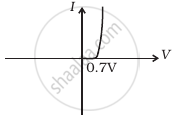Advertisements
Advertisements
प्रश्न
A plate current of 10 mA is obtained when 60 volts are applied across a diode tube. Assuming the Langmuir-Child relation \[i_p \infty V_p^{3/2}\] to hold, find the dynamic resistance rp in this operating condition.
उत्तर
According to Lamgmuir-Child Law,
the relation between plate current (ip) and the plate voltage (Vp) is given by
\[i_p = C {V_p}^{3/2} ............(1)\]
Differentiating equation (1) with respect Vp, we get:-
\[\frac{d i_p}{d V_p} = \frac{3}{2}C {V_p}^{1/2} ............(2)\]
Dividing (2) and (1), we get:-
\[\frac{1}{i_p}\frac{d i_p}{d v_p} = \frac{3/2C {V_p}^{1/2}}{C {V_p}^{3/2}}\]
\[ \Rightarrow \frac{1}{i_p} . \frac{d i_p}{d v_p} = \frac{3}{2 V_p}\]
The dynamic resistance is given by:-
\[\frac{d v_p}{d i_p} = \frac{2 V_p}{3 i_p}\]
\[ r_p = \frac{2 V_p}{3 i_p}\]
\[ r_p = \frac{2 \times 60}{3 \times 10 \times {10}^{- 3}}\]
\[ r_p = 4 \times {10}^3 = 4 k\Omega\]
APPEARS IN
संबंधित प्रश्न
When a forward bias is applied to a p-n junction, it ______.
With reference to semiconductor devices, define a p-type semiconductor and a Zener diode.
Plot a graph showing variation of current versus voltage for the material GaAs ?
The graph shown in the figure represents a plot of current versus voltage for a given semiconductor. Identify the region, if any, over which the semiconductor has a negative resistance.
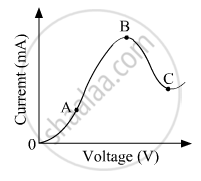
The plate current in a diode is 20 mA when the plate voltage is 50 V or 60 V. What will be the current if the plate voltage is 70 V?
The power delivered in the plate circular of a diode is 1.0 W when the plate voltage is 36 V. Find the power delivered if the plate voltage is increased to 49 V. Assume Langmuir-Child equation to hold.
The dynamic plate resistance of a triode value is 10 kΩ. Find the change in the plate current if the plate voltage is changed from 200 V to 220 V.
In semiconductor physics, what is meant by:
(i) rectifier
(ii) an amplifier
(iii) an oscillator
Basic materials used in the present solid state electronic devices like diode, transistor, ICs, etc are ______.
The drift current in a p-n junction is from the ______.
In forward bias width of potential barrier in a p + n junction diode
The expected energy of the electron at absolute zero is called:-
In a semiconductor diode, the barrier potential offers opposition to only
Avalanche breakdown is due to ______.
Consider a box with three terminals on top of it as shown in figure (a):
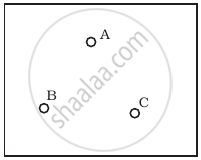 (a) |
Three components namely, two germanium diodes and one resistor are connected across these three terminals in some arrangement. A student performs an experiment in which any two of these three terminals are connected in the circuit shown in figure (b).
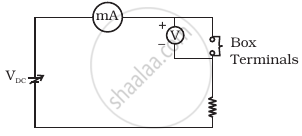 (b) |
The student obtains graphs of current-voltage characteristics for unknown combination of components between the two terminals connected in the circuit. The graphs are
(i) when A is positive and B is negative
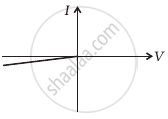 (c) |
(ii) when A is negative and B is positive
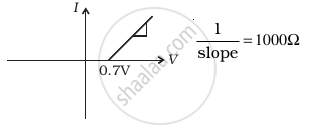 (d) |
(iii) When B is negative and C is positive
|
(e) |
(iv) When B is positive and C is negative
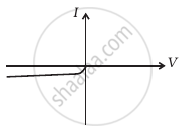 (f) |
(v) When A is positive and C is negative
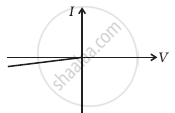 (g) |
(vi) When A is negative and C is positive
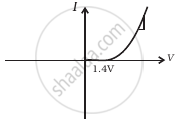 (h) |
From these graphs of current-voltage characteristics shown in figure (c) to (h), determine the arrangement of components between A, B and C.
Draw V-I characteristics of a p-n Junction diode.
Describe briefly the following term:
breakdown voltage in reverse biasing
Read the following paragraph and answer the questions that follow.
| A semiconductor diode is basically a pn junction with metallic contacts provided at the ends for the application of an external voltage. It is a two-terminal device. When an external voltage is applied across a semiconductor diode such that the p-side is connected to the positive terminal of the battery and the n-side to the negative terminal, it is said to be forward-biased. When an external voltage is applied across the diode such that the n-side is positive and the p-side is negative, it is said to be reverse-biased. An ideal diode is one whose resistance in forward biasing is zero and the resistance is infinite in reverse biasing. When the diode is forward biased, it is found that beyond forward voltage called knee voltage, the conductivity is very high. When the biasing voltage is more than the knee voltage the potential barrier is overcome and the current increases rapidly with an increase in forward voltage. When the diode is reverse biased, the reverse bias voltage produces a very small current of about a few microamperes which almost remains constant with bias. This small current is a reverse saturation current. |
- In the given figure, a diode D is connected to an external resistance R = 100 Ω and an emf of 3.5 V. If the barrier potential developed across the diode is 0.5 V, the current in the circuit will be:

(a) 40 mA
(b) 20 mA
(c) 35 mA
(d) 30 mA - In which of the following figures, the pn diode is reverse biased?
(a)
(b)
(c)
(d)
- Based on the V-I characteristics of the diode, we can classify the diode as:
(a) bilateral device
(b) ohmic device
(c) non-ohmic device
(d) passive element
OR
Two identical PN junctions can be connected in series by three different methods as shown in the figure. If the potential difference in the junctions is the same, then the correct connections will be:
(a) in the circuits (1) and (2)
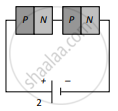
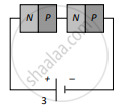
(b) in the circuits (2) and (3)
(c) in the circuits (1) and (3)
(d) only in the circuit (1) 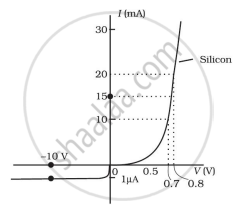
The V-I characteristic of a diode is shown in the figure. The ratio of the resistance of the diode at I = 15 mA to the resistance at V = -10 V is
(a) 100
(b) 106
(c) 10
(d) 10-6
What is meant by forward biasing of a semiconductor diode?
